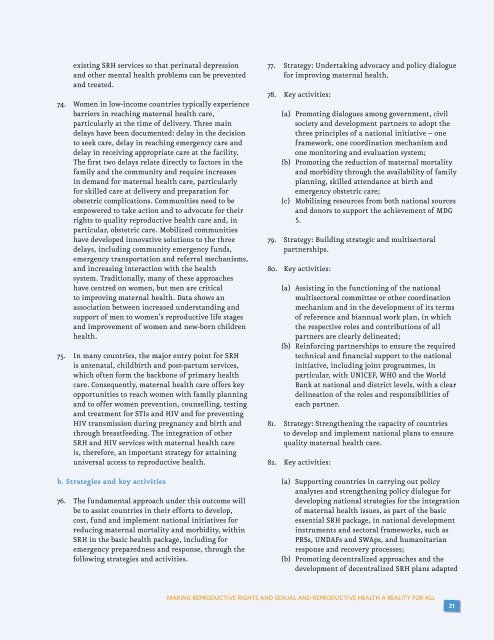Sexual and Reproductive Health Framework - UNFPA
Sexual and Reproductive Health Framework - UNFPA
Sexual and Reproductive Health Framework - UNFPA
You also want an ePaper? Increase the reach of your titles
YUMPU automatically turns print PDFs into web optimized ePapers that Google loves.
existing SRH services so that perinatal depression<strong>and</strong> other mental health problems can be prevented<strong>and</strong> treated.74. Women in low-income countries typically experiencebarriers in reaching maternal health care,particularly at the time of delivery. Three maindelays have been documented: delay in the decisionto seek care, delay in reaching emergency care <strong>and</strong>delay in receiving appropriate care at the facility.The first two delays relate directly to factors in thefamily <strong>and</strong> the community <strong>and</strong> require increasesin dem<strong>and</strong> for maternal health care, particularlyfor skilled care at delivery <strong>and</strong> preparation forobstetric complications. Communities need to beempowered to take action <strong>and</strong> to advocate for theirrights to quality reproductive health care <strong>and</strong>, inparticular, obstetric care. Mobilized communitieshave developed innovative solutions to the threedelays, including community emergency funds,emergency transportation <strong>and</strong> referral mechanisms,<strong>and</strong> increasing interaction with the healthsystem. Traditionally, many of these approacheshave centred on women, but men are criticalto improving maternal health. Data shows anassociation between increased underst<strong>and</strong>ing <strong>and</strong>support of men to women’s reproductive life stages<strong>and</strong> improvement of women <strong>and</strong> new-born childrenhealth.75. In many countries, the major entry point for SRHis antenatal, childbirth <strong>and</strong> post-partum services,which often form the backbone of primary healthcare. Consequently, maternal health care offers keyopportunities to reach women with family planning<strong>and</strong> to offer women prevention, counselling, testing<strong>and</strong> treatment for STIs <strong>and</strong> HIV <strong>and</strong> for preventingHIV transmission during pregnancy <strong>and</strong> birth <strong>and</strong>through breastfeeding. The integration of otherSRH <strong>and</strong> HIV services with maternal health careis, therefore, an important strategy for attaininguniversal access to reproductive health.b. Strategies <strong>and</strong> key activities76. The fundamental approach under this outcome willbe to assist countries in their efforts to develop,cost, fund <strong>and</strong> implement national initiatives forreducing maternal mortality <strong>and</strong> morbidity, withinSRH in the basic health package, including foremergency preparedness <strong>and</strong> response, through thefollowing strategies <strong>and</strong> activities.77. Strategy: Undertaking advocacy <strong>and</strong> policy dialoguefor improving maternal health.78. Key activities:(a) Promoting dialogues among government, civilsociety <strong>and</strong> development partners to adopt thethree principles of a national initiative -- oneframework, one coordination mechanism <strong>and</strong>one monitoring <strong>and</strong> evaluation system;(b) Promoting the reduction of maternal mortality<strong>and</strong> morbidity through the availability of familyplanning, skilled attendance at birth <strong>and</strong>emergency obstetric care;(c) Mobilizing resources from both national sources<strong>and</strong> donors to support the achievement of MDG5.79. Strategy: Building strategic <strong>and</strong> multisectoralpartnerships.80. Key activities:(a) Assisting in the functioning of the nationalmultisectoral committee or other coordinationmechanism <strong>and</strong> in the development of its termsof reference <strong>and</strong> biannual work plan, in whichthe respective roles <strong>and</strong> contributions of allpartners are clearly delineated;(b) Reinforcing partnerships to ensure the requiredtechnical <strong>and</strong> financial support to the nationalinitiative, including joint programmes, inparticular, with UNICEF, WHO <strong>and</strong> the WorldBank at national <strong>and</strong> district levels, with a cleardelineation of the roles <strong>and</strong> responsibilities ofeach partner.81. Strategy: Strengthening the capacity of countriesto develop <strong>and</strong> implement national plans to ensurequality maternal health care.82. Key activities:(a) Supporting countries in carrying out policyanalyses <strong>and</strong> strengthening policy dialogue fordeveloping national strategies for the integrationof maternal health issues, as part of the basicessential SRH package, in national developmentinstruments <strong>and</strong> sectoral frameworks, such asPRSs, UNDAFs <strong>and</strong> SWAps, <strong>and</strong> humanitarianresponse <strong>and</strong> recovery processes;(b) Promoting decentralized approaches <strong>and</strong> thedevelopment of decentralized SRH plans adaptedMAKING REPRODUCTIVE RIGHTS AND SEXUAL AND REPRODUCTIVE HEALTH A REALITY FOR ALL21
















